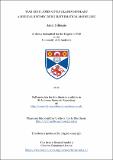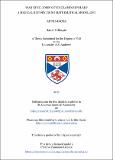Files in this item
Was King John of England bipolar? : a medical history using mathematical modelling
Item metadata
| dc.contributor.advisor | Harrison, David James | |
| dc.contributor.author | Gillespie, Janet Patricia | |
| dc.coverage.spatial | 251 p. | en_US |
| dc.date.accessioned | 2017-11-30T10:16:48Z | |
| dc.date.available | 2017-11-30T10:16:48Z | |
| dc.date.issued | 2017-06-23 | |
| dc.identifier.uri | https://hdl.handle.net/10023/12195 | |
| dc.description.abstract | BACKGROUND - Bipolar disorder has been postulated as an explanation for King John's inconsistencies of leadership and vagaries of character. Changes in activity, matching those in mood, are core features of the condition. METHOD - A measure of King John's activity was derived from his travelling itinerary. Change Point Analysis (CPA) was used to detect significant changes in that travelling activity and from them, to identify clinically compliant, high and low, activity time periods. The results were tested against an alternative mathematical model (Bollinger Bands™), three alternative parameters and two comparator itineraries (familial & non-familial). Using primary historical sources and published analyses, bipolar symptoms were identified and their temporal relationship to the ICD-10 compliant CPA periods evaluated. The influence of circumstances was also evaluated using primary sources and a representative sequential sample (1200-1204). RESULTS - CPA identified 83 periods of changed travelling activity. These changes were mathematically independent of the availability of the historical sources that underpin the itinerary. From these, 37 high and 22 low periods complied with current diagnostic guidelines and demonstrated descriptive and statistical similarities to those found in the bipolar literature. Analyses using alternative mathematical modelling and different parameters showed similar changes; analyses of comparator itineraries showed a possible familial trait. Of the 17 bipolar symptoms identified, all were found in CPA periods of appropriate polarity. Of the 23 sequential periods, 10 showed evidence of behaviour that was difficult to attribute to circumstances. CONCLUSIONS & OUTCOMES - The pattern of changes in King John's activity are highly suggestive of bipolar disorder with primary historical sources describing synchronous bipolar behaviour. This may alter our understanding both of King John and of Magna Carta. Change Point Analysis merits greater consideration when analysing time based data, as does the use of activity as an objective marker of human behaviour. | en_US |
| dc.language.iso | en | en_US |
| dc.publisher | University of St Andrews | |
| dc.rights | Attribution-NonCommercial-NoDerivatives 4.0 International | * |
| dc.rights.uri | http://creativecommons.org/licenses/by-nc-nd/4.0/ | * |
| dc.subject | King John of England | en_US |
| dc.subject | Magna Carta | en_US |
| dc.subject | Bipolar disorder | en_US |
| dc.subject | Activity | en_US |
| dc.subject | Change point analysis | en_US |
| dc.subject | Bollinger Bands™ | en_US |
| dc.subject | Mania | en_US |
| dc.subject | Depression | en_US |
| dc.subject.lcc | DA208.G5 | |
| dc.subject.lcsh | John, King of England, 1167-1216--Mental health | |
| dc.subject.lcsh | John, King of England, 1167-1216--Travel | |
| dc.subject.lcsh | Manic-depressive illness--Diagnosis--Mathematical models | |
| dc.title | Was King John of England bipolar? : a medical history using mathematical modelling | en_US |
| dc.type | Thesis | en_US |
| dc.type.qualificationlevel | Doctoral | en_US |
| dc.type.qualificationname | PhD Doctor of Philosophy | en_US |
| dc.publisher.institution | The University of St Andrews | en_US |
The following licence files are associated with this item:
This item appears in the following Collection(s)
Except where otherwise noted within the work, this item's licence for re-use is described as Attribution-NonCommercial-NoDerivatives 4.0 International
Items in the St Andrews Research Repository are protected by copyright, with all rights reserved, unless otherwise indicated.



